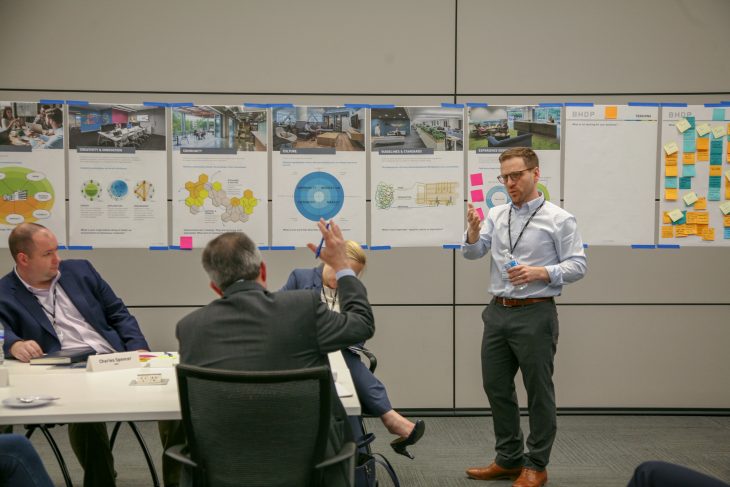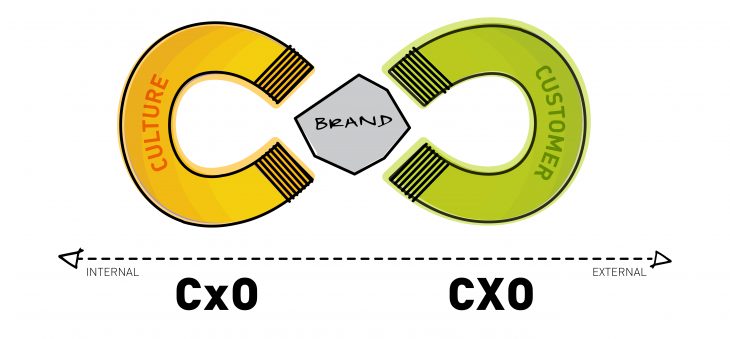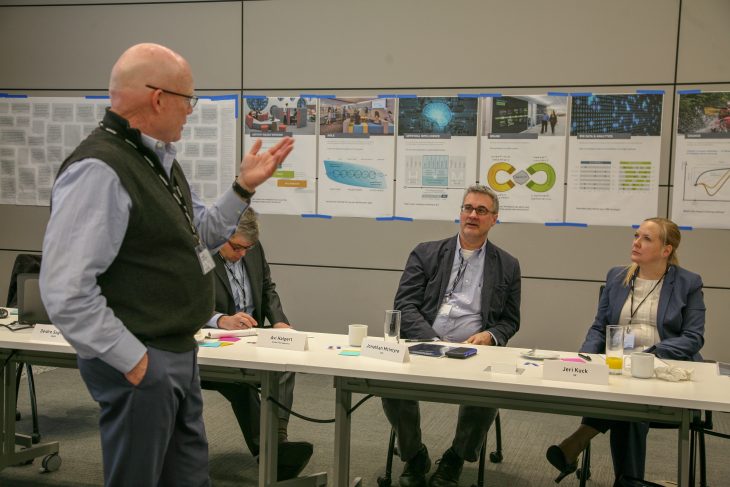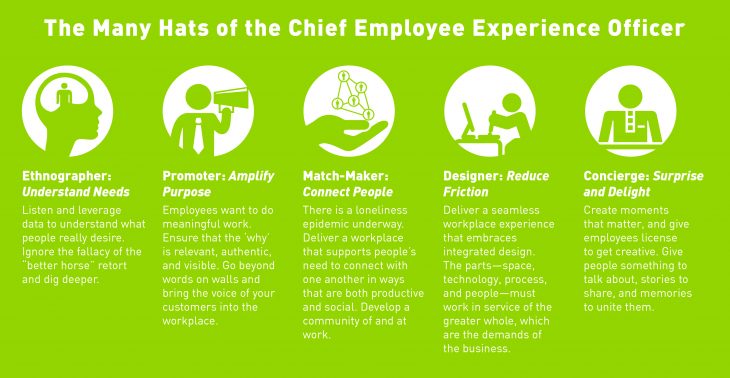As the conversation about the employee experience balloons, the time has come to harness that hot air. Why not add a Chief Employee Experience Officer to give employees a voice?

Who hasn’t been to a workshop, focus group, or executive seminar where someone proposes that CRE, IT, and HR should function like a three-legged stool? Admittedly, I’ve been that person. I’ve also nodded along enthusiastically when someone else has been that person. It’s a good idea, and one that service-minded professionals almost universally agree on. It’s also incomplete. Stools are fundamentally unstable, after all, unless you add a seat. And indeed, there is a missing seat—not just on our proverbial stool—but a seat at the executive table.
As organizations continue to add titles to fill the crowded C-suite to account for an expanded set of stakeholders, there is one perspective that is woefully under-represented: employees. As the conversation about the employee experience balloons, the time has come to harness that hot air. Why not add a Chief Employee Experience Officer to give employees a voice? Since the CEO and the CXO are already taken, let’s call them the CxO – the lower-case “x” to account for experiences large and small.
Experience matters.
In their seminal work, The Experience Economy, Pine and Gilmore make the case that the key to accessing untapped market value and generating lasting customer loyalty is staging experiences. They argue the difference between a service provider and an experience creator, is essentially stagecraft: valuing and designing the relationship that customers have with a company, rather than monetizing a stream of transactions. The examples they cite are abundant. Starbucks, Disney, and Nordstrom were the vanguard of the late 20th century push into crafting (and charging a premium for) authentic, meaningful, and memorable experiences. Now twenty years into the 21st century, and with the digital transformation well underway, consumer experiences in physical space have been augmented by technology, which continually expands the landscape.
As designers, workplace strategists, and leaders of corporate real estate, you might wonder what the consumer space has to do with the workplace. Starbucks doesn’t pay its customers to enjoy its coffee, but employees show up for a regular paycheck. The connection between the consumer space and the workplace is demand. Consumers demand more than a cup of hot coffee, and Starbucks supplies experiences that meet that demand. Inversely, employees supply their time and expertise to meet the demand of their employers. So, employees control the supply. Here’s where it gets interesting, though. In businesses where experience matters, demand straddles both sides of the transaction. Leading organizations understand that delivering engaging workplace experiences can stimulate demand (desire) on the supply side of the labor ledger.
Those of us that wage battle in the war for talent know that employee engagement is not a transactional affair. Rather, top talent desires a workplace experience that resonates with and reinforces the passion they have for their work. If you are wondering, “Isn’t a great paycheck, a good benefits package, a clean and safe place to come to work, and a stable career enough?” No, it’s not… not if you want to compete. In short, premium talent wants more than a job. They demand a relationship, and in that sense, experience matters more than ever.

Whose job is it anyway?
In the consumer space, the responsibilities of the Chief Marketing Officer (CMO) have expanded dramatically in the last twenty years. Once the steward of the brand, CMOs are increasingly becoming Chief Experience Officers (CXOs) with a purview that extends along all touchpoints—be they physical, digital, emotional, or otherwise—that consumers have with an organization. Consumer loyalty is contingent upon building an enduring relationship, and CXOs understand there are no longer first, second and third moments of truth for their brands. Rather, the prevailing marketing logic holds that the bond between customer and brand is constantly in flux.
Similarly, the bond between employer and employee is being tested continuously by the practical demands of the work at hand. One way to build connections with employees that endure the strain of the day-to-day is to demonstrate authentic consideration and care. All organizations invest in their workplace. Organizations looking to capitalize on that investment must prioritize and take ownership of the employee experience. Viewed once again through the lens of the market, it’s clear that there is a vacancy in most organizations to be filled. According to Gilmore and Pine, “A new approach to demand creation is needed, one that forces a company to be what it says it is; and someone needs to head this new effort.” If the CXO is responsible for experiences that external customers have with an organization, then the CxO owns a similar and symmetrical role internally. The Académie du Service has called this notion the Symmetry of Attention.

According to Accenture, “the parallels between a superior customer experience (CX) and employee experience (EX) are striking. An optimized CX generates loyalty and additional sales. A stellar EX attracts talent, boosts workforce engagement, productivity and retention. This in turn directly improves a business’ financial performance.” There are real gains to be had. Based on research from Gallup, companies with highly engaged workforces are 21 percent more profitable than those with poor engagement. In highly competitive industries, that’s likely the margin between sustainability and irrelevancy. It’s simply too important to ignore.
The role of the CxO.
The new position captures several shifts in the way people think about the workplace. The CxO embraces the movement away from business administration and towards workplace hospitality. The CxO acknowledges experiences in the consumer space have forever altered the workforces’ expectations of the workplace. The CxO believes the digital and physical space are in the process of collapsing into one another. And finally, the CxO eschews the notion of step-wise career progressions along pre-defined paths.
The CxO is responsible for crafting a workplace experience that authentically reflects the mission, vision, and values of the company; creating memorable, meaningful, and purposeful connections; building a team of service-minded stewards that work on behalf of the workforce; delivering tools and technology to enable seamless workflow; and instilling enthusiasm if not excitement for the work at hand. It’s a big job. The case for the Chief Employee Experience Officer hinges on the notion that leading companies take ownership for the relationships that people have with their organization—all the relationships. In The Power of Full Engagement, Jim Loehr makes the case that the stories inside an organization should match those outside it. That’s authentic leadership, and the CxO is nothing if not the most authentic leader.

SIDEBAR: The Many Hats of the Chief Employee Experience Officer
Ethnographer: Understands Needs
Listen and leverage data to understand what people really desire. Ignore the fallacy of the “better horse” retort and dig deeper.
Promoter: Amplifies Purpose
Employees want to do meaningful work. Ensure that the ‘why’ is relevant, authentic, and visible. Go beyond words on walls and bring the voice of your customers into the workplace.
Match-Maker: Connects People
There is a loneliness epidemic underway. Deliver a workplace that supports people’s need to connect with one another in ways that are both productive and social. Develop a community of and at work.
Designer: Reduces Friction
Deliver a seamless workplace experience that embraces integrated design. The parts—space, technology, process, and people—must work in service of the greater whole, which are the demands of the business.
Concierge: Surprises and Delights
Create moments that matter and give employees license to get creative. Give people something to talk about, stories to share, and memories to unite them.


